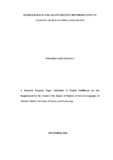| dc.description.abstract | Vihiga Sub-County like most of Western Kenya, is endowed with an equatorial climate, thus supports a rich diversity of flora and fauna. On the contrary, the area is susceptible to climate change impacts because, other than one major cause of global warming being emission of Greenhouse gases (carbon dioxide, methane and chlorofloro carbons) in the mainly urban and industrial areas, the major cause of global warming and climate change in Vihiga Sub-County are human related activities that contribute to increased emissions of Greenhouse gases. This has had major negative impacts conspicuously affecting the local population, which highly depends on natural resources for livelihood. Crop production yields have decreased over the years, exposing the area to risks of food insecurity. It is on this scenario that this research seeks to find out the relationship between gender roles, climate change, and adaptation in crop production. This research is important in creating awareness on the gender roles discourse and climate change issue, since majority at grassroots cannot comprehend how the two relate despite the issue of gender maturing quite rapidly. This research is justified since, a lot has been written focusing on how women‘s gender roles been affected leaving out men as perpetrators of climate change. Thus, gender inequality. The research is guided by three specific objectives which are to determine the extent of climate change variability in Vihiga Sub-County, to distinguish gender contribution to climate change and to compare gender roles in the adaptation of crop production to climate change. The research will adopt both qualitative and quantitative approach using a descriptive design. Purposive sampling will be adopted and sample size of 375 in a population of about 16, 293 households will be preferred.Data collection will combine participant observation, questionnaires, interviews, focused group discussions with selected farmers and government document analysis of meteorological data. Content analysis will be used for qualitative data and correlation analysis used for quantitative data obtained in comparison with that from the meteorological department. The research will help in building on the empirical evidence; given that although the issue of gender is maturing rapidly little groundwork has been done in Vihiga Sub-County. Results from this research will aid in policy formation and improving adaptation strategies for both men and women so as to attain the Sustainable Development Goals, SDGs on food insecurity. | en_US |

